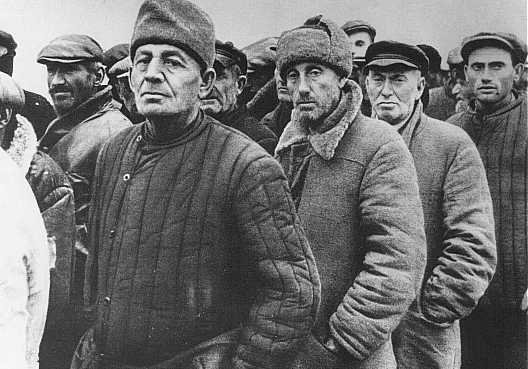(Wikipedia)
Then the Einsatzgruppen D rushed the city, shooting any Jews they could find. After that, control of the city was given over to the Romanians, who had joined with the Axis powers, and wanted to prove itself to them. Jews were concentrated in Odessa from neighboring towns and either killed or placed into camps in Transnistria, west of Odessa and now a part of Moldova (it's also currently an old-school communist illegal state, but that subject would be too short for a blog) where more people died from sickness from the unsanitary conditions than gun-murder.
Ukrainian Jews Registering with Romanian Authorities (US Holocaust Memorial Museum)
It was easy to hide from the disorganized Romanian forces, led by general Ion Antonescu if one had hidden in the initial searches, and once hid, it was best to stay that way-- Romanian tactics were especially brutal, in an attempt to impress the German army. Exterminations were carried out by gathering groups of Jews and suspected communists and taking a flamethrower to the crowd. In a message that was ordered to be burned (a testament to the disorganization of Antonescu's army), Antonescu wrote:
"1. Execution of all Jews from Bessarabia [Moldova/Transnistria] who have sought refuge in Odessa.
"2. All individuals who fall under the stipulations of October 23, 1941 [ordering the killing of 'Communists'], not yet executed and the others who can be added thereto will be placed inside a building that will be mined and detonated. This action will take place on the day of the burial of the victims [of the bombing of Romanian headquarters attributed to Odessans].
"3. This order will be destroyed after being read"
(Charles King)
The exact figure is unclear, but it is estimated that a total of 300,000 Jews, not including suspected communists, were killed by Antonescu's army. The people of Odessa were surprisingly complacent, considering Jewish people comprised over 1/3 of the population, their friends and neighbors. Citizens actually unknowingly cause more trouble for the Romanians when they sent in tips about possible Jews and Communists: they were so used to ratting out everyone under Stalin, they would send in letters saying something akin to "my neighbor's apartment is very messy, and he reads too much, because of this I think he is a communist", just to get their neighbor's space, and caused bureaucratic stall in the Romanian army. Not admitting this complacency contributes to Ukraine being barred out of the EU (among other serious problems).
Romanian stamps commemorating the conquest of Odessa and the "crusade against Bolshevism" (Wikipedia)
That is not to say that Odessans did not fight back. The next entry will detail the struggle of the catacomb partisans.
King, Charles. Odessa: Genius And Death In A City Of Dreams. New York: W.W.
Norton & Company, Inc., 2011. N. pag. Amazon Kindle. Web. 4 Apr. 2012.
Norton & Company, Inc., 2011. N. pag. Amazon Kindle. Web. 4 Apr. 2012.



This comment has been removed by a blog administrator.
ReplyDelete